AQA A-Level Psychology - Approaches
1/104
There's no tags or description
Looks like no tags are added yet.
Name | Mastery | Learn | Test | Matching | Spaced |
|---|
No study sessions yet.
105 Terms
Wilhelm Wundt
Opened first ever psychological lab in Germany in 1879, marking the start of psychology being considered a science
Aimed to use standardised methods (introspection) to analyse human consciousness.
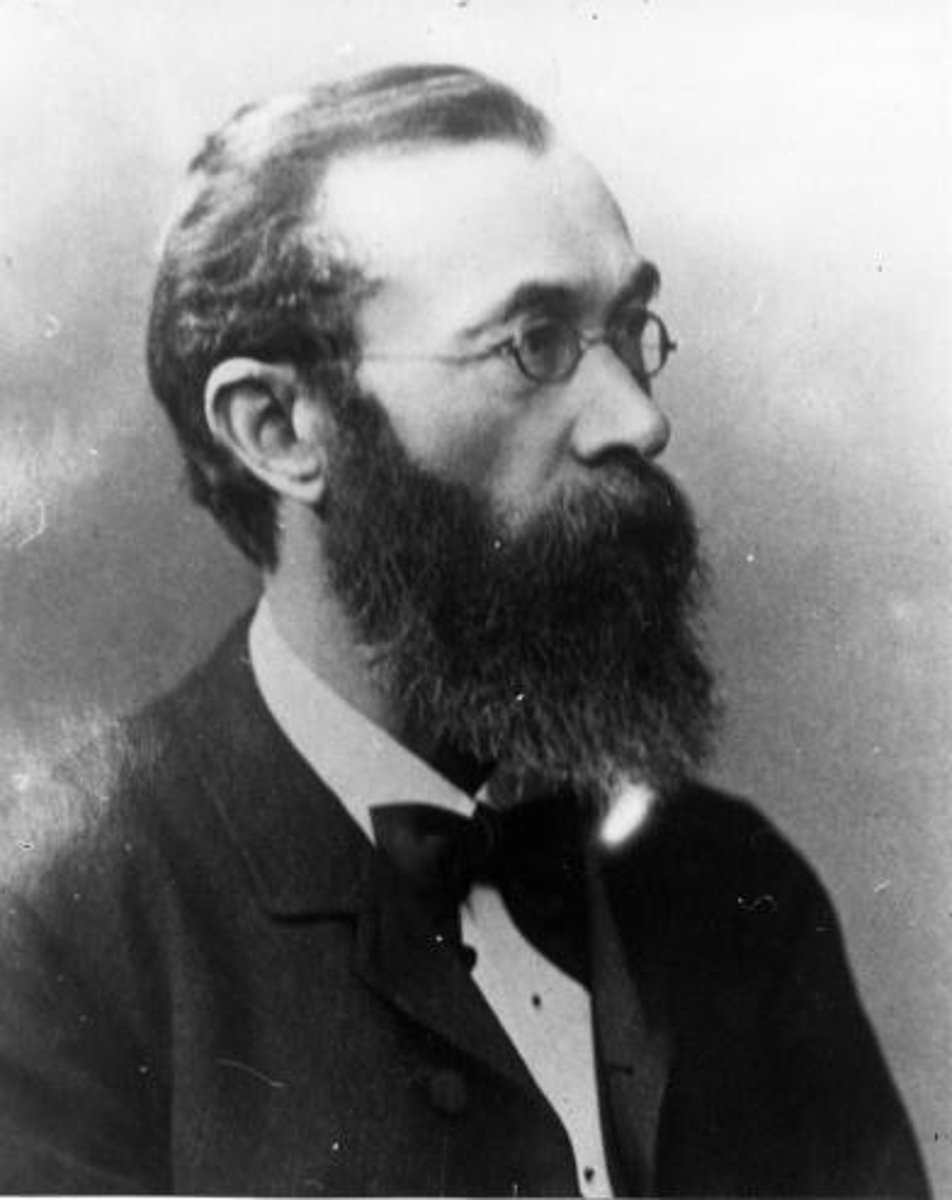
Introspection
the examination/ observation of one’s own mental and emotional processes
Wundt did this by presenting stimuli to ppts and asked them to ‘think aloud’
Origins of psychology - Evaluation
-Wundt's methods were unreliable:
- non observable responses
- hard to reproduce
-Introspection is inaccurate
+Scientific approach
- Brought objective systematic methods
-Lab studies produce low ecological results
Assumption of the behaviourist approach
psychologists should only study observable, quantifiable behaviour
Tabula Rasa
Humans are equal to animals and shouldn’t be regarded as more complex
research on animal behaviour is directly relevant to humans
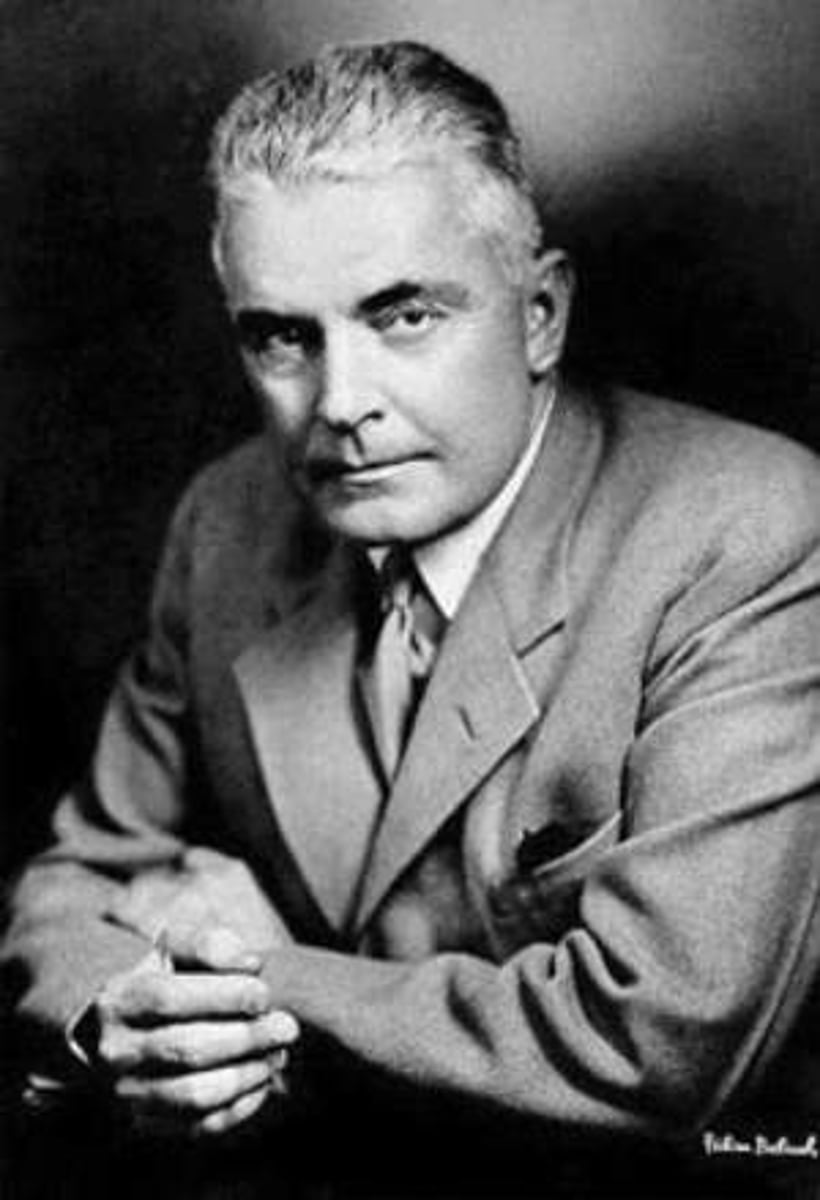
Classical conditioning
Learning through association of an existing involuntary reflex with a new stimuli, creating a conditioned response
Pavlov research - dogs associate sound of bell with food if bell is rung consistently before feeding.
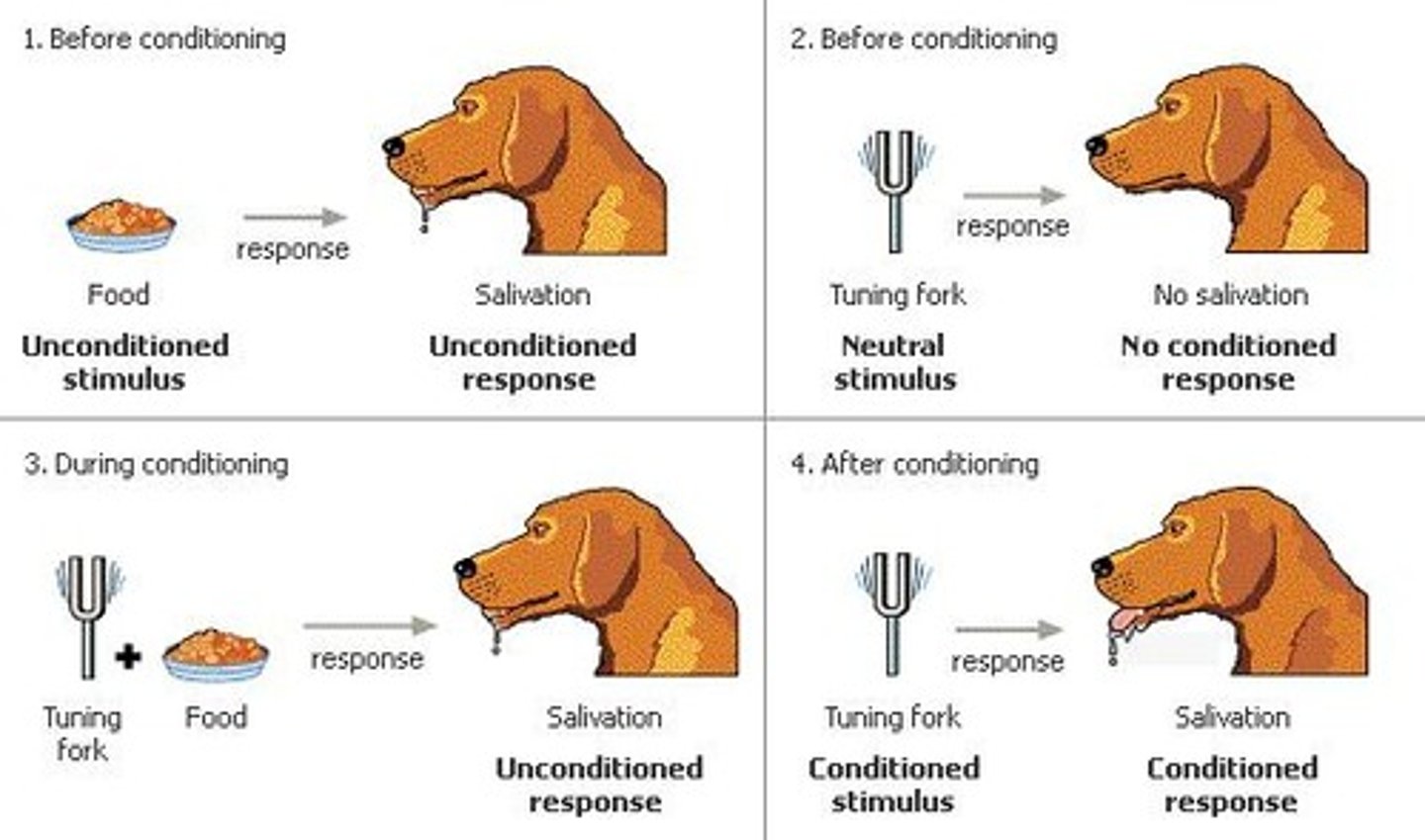
Classical conditioning procedure
Dogs were conditioned to associate the sound of a bell (neutral stimulus) with food (unconditioned stimulus).
Resulted in the dogs producing a salivation response (conditioned response) at the bell sound (conditioned stimulus), even when no food was present.
He demonstrated that repeated exposure to an event leads to a learned and uncontrollable behaviour. Process could be used to explain the acquisition of phobias and development of attachment.
Operant conditioning
Learning through consequences for behaviour, whether that be reinforcement or punishment
Skinner (1953) suggested that learning is an active process where humans and animals operate in their environment.
There are 3 types of consequences of behaviour: Positive reinforcement, Negative reinforcement, punishment.
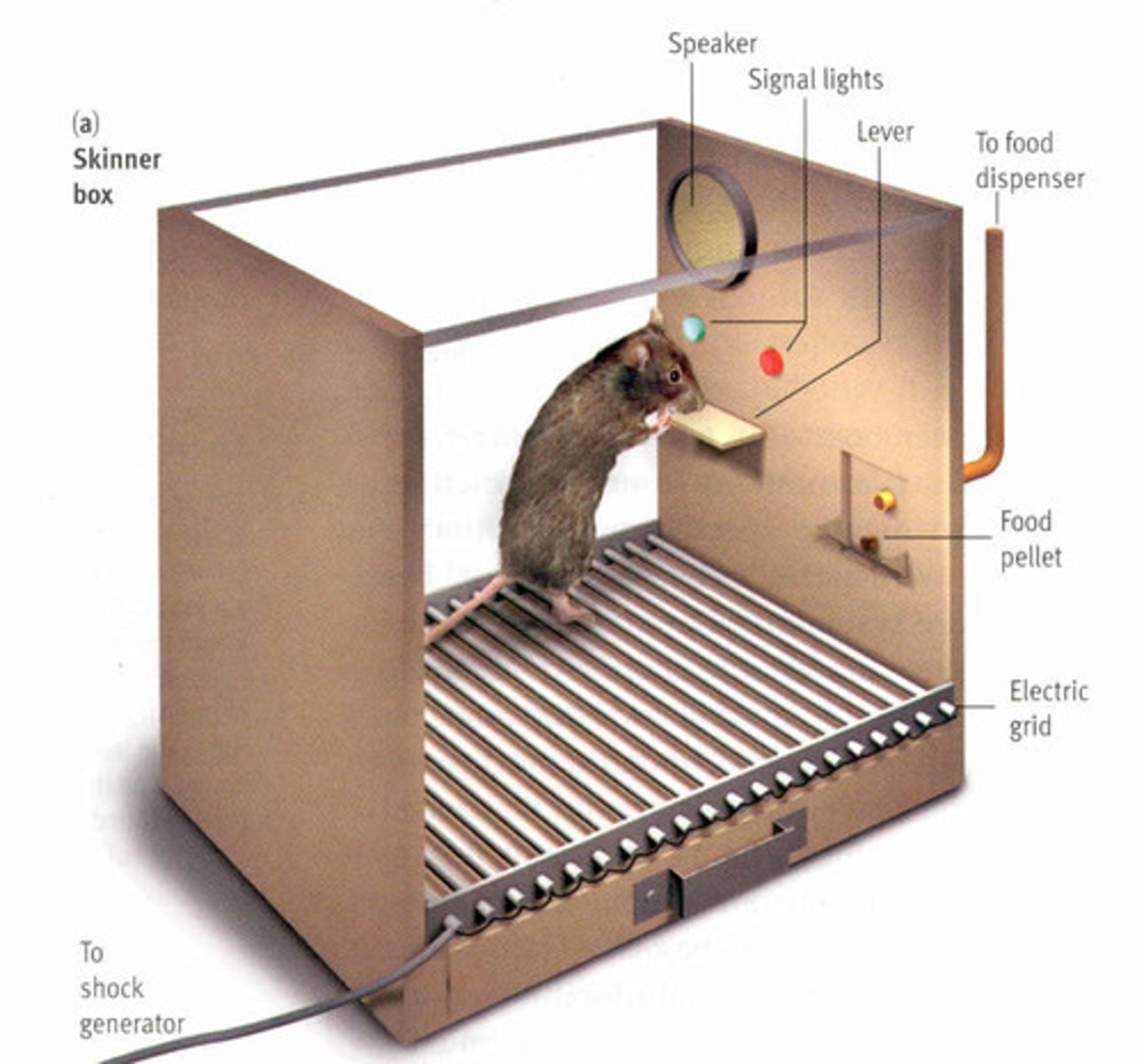
Operant conditioning procedure
Skinner tested his theory on rats, using the ‘Skinner box’ to examine it The animals would move around the cage, and when a lever was pressed by accident, it would be rewarded with a food pellet. Each time, they would be positively reinforced each time they pressed the lever and were rewarded with food. Therefore, a voluntary behaviour which is repeated is receive the reward again.
Positive reinforcement
When something is added to increase the likelihood of behaviour repeating
Negative reinforcement
When something is removed to increase the likelihood of behaviour repeating
Positive punishment
When something unpleasant is added to decrease the likelihood of behaviour repeating
Negative punishment
Something is removed to decrease the likelihood of behaviour repeating
Behaviourist Approach - Evaluation
+Scientific credibility: experiments by Pavlov and Skinner rejected the earlier emphasis on introspection, encouraging research to focus on more objective dimensions of behaviour. This increases a valid and reliable understanding of behaviour, giving psychology greater scientific credibility.
+Real life application: made important contributions to modern understanding of mental illness, phobias, addiction e.g led to the development of systematic desensitisation
-Mechanistic view of behaviour: criticised for its limited view on the origins of behaviour - behaviourists ignore other factors like emotion in influencing behaviour. It is very reductionist as it reduces behaviour to learning, oversimplifying human behaviour
-Environmental determinism: believes behaviour is controlled as simple as a S-R association and ignores the possible influence of free will on human behaviour.
Assumptions of social learning theory
Proposes that new behaviours can be acquired by observing and imitating the behaviours perfomed by role models in a social environment
Recognises the importance of cognitive processes and rejects the notion that learning is purely the outcome of a stimulus-response loop.
Combines behaviourist ideas of learning through pur environment and cognitive ideas of involvement of IMP
Takes into account mediational processes
SLT - Vicarious reinforcement
Process of learning by observing the consequences of actions for other people
SLT - Mediational processes
Cognitive factors that learning
Attention - Extent to which we notice certain behaviour
Retention - How well the behaviour is remembered
Motor Reproduction - The ability of the observer to perform the behaviour
Motivation - The will to perform the behaviour
SLT - Identification
When observer associates themselves with a role model and wants to be like them
SLT - Role model
an individual whose behaviour, attitudes or achievements are emulated by others, particularly younger/ less experienced individuals
SLT - Bandura's bobo doll study
Bandura (1965)
Aim: to investigate whether aggression can be learned through SLT principles
Procedure: 72 children were split into 3 groups - aggressive role model (child played in room while . the doll), non-aggressive role model (same thing but adult played quietly in the corner with a construction set) and control (did not see a role model). The aggressive and non-aggressive groups were subdivided into 2 (gender of the role model) and further divided by the gender of the child. Children were deliberately frustrated by being sent to another room where they were told not to play with toys, then placed alone in a room with aggressive toys, non-aggressive toys and a bobo doll for 20 mins while observed.
Result: children who saw the aggressive model produced more aggressive acts. Boys imitated same-sex models more than girls. Girls imitated more physical aggression if they saw a male model and more verbal aggression if they saw a female model. This suggests that aggressive behaviour can be learned through observation and imitation of a model.

Social Learning Theory - Evaluation
+Plentiful research support: demonstrates support for different aspects of SLT including modelling and vicarious reinforcement, adding credibility to the key principles of this theory.
+Application to real world issues: after 9pm TV shows, rating of films or games as A or PG
-Over reliant on evidence from lab studies: methodology used can be criticised. Bandura made his experiments very contrived in nature, thus there is a possibility of demand characteristic occurring. The research may tell us little about how children learn aggression in everyday life
-Environmentally deterministic: it sees behaviour as environmentally determined whereas some behaviours may be innate
Assumptions of Cognitive approach
argues that internal mental processes can and should be studied scientifically. As a result, the cognitive approach has investigated areas of human behaviour that were neglected by behaviourists (such as memory, perception, and thinking). These processes are private and cannot be observed, so cognitive psychologists study them indirectly by making inferences about what is going on inside people’s minds on the basis of their behaviour.
Cognitive approach - Internal Mental Processes
Private operations of the mind that mediate between stimulus and response and can’t be observed (e.g memory) that can and should be studied scientifically
Cognitive Approach - Schema
mental framework/ representation of an object/ event/ concept that influences cognitive processing, based on past experiences of assimilation and accommodation
Inference
Process whereby cognitive psychologists draw conclusions about mental processes by observation
Information Processing Approach
a cognitive theory that views the mind as a computer-like system that processes information through various stages
Theoretical models
more, abstract diagrams represnting steps involved in IMP, suggesting information will process through several stages (assists with research and testing hypothesis)
Computer models
more concrete, performs simulations of mental processes (assista with research and testing of hypothesis)
Cognitive approach - black box theory
cognitive theory that describes how psychologists cannot physically see inside, but van scientifically study and IMP within by making inferences
Cognitive neuroscience
Scientific study of biological structures that underpin cognitive processes that are active in various IMP
In the 1860s Broca identified that damage to the frontal lobe can permanently impaired speech.
In last 20 years, technology has advanced to allow brain imaging scans. Tulving discovered that different types of long term memory may be located in different parts of the brain, able to pinpoint which structures are active in various IMP.
Recently, AI development and studying brain waves
Cognitive Approach - Evaluation
+Scientific and objective methods - Highly controlled in a lab setting. Reliable and objective data produced. Furthermore, cognitive neuroscience has enabled biology and cognitive psychology to come together, establishing a credible scientific basis.
+Less determinist than the other approaches: it is founded on soft determinism - recognises that our cognitive system can only operate within the limits of what we know, but that we are free to think before responding to a stimulus. This is a more reasonable ‘interactionist’ position than some other approaches. Therefore, it is more flexible than the hard determinist stance of other approaches like behaviourism.
-Machine reductionism - ignores the influence of human emotion and motivation on the cognitive system, simplifying the human mind to a computer, and how this may affect our ability to process information e.g research has found that human memory may be affected by emotional factors such as anxiety on eyewitness testimony
-Not overly applicable to everyday life - Can be too theoretical and abstract as cognitive psychologists can only make infer mental processes from the behaviour they observe. Additionally, studies of mental processes often use artificial stimuli may not represent everyday memory experiences e.g Peterson & Peterson using three letter trigrams. Therefore can lack external validity.
Assumptions of Biological Approach
Everything psychological is at first biological and investigates how biological structures and processes such as genes, neurochemistry, and the nervous system impacts behaviour.
Genes
makes up chromosomes and DNA, transmitted from parent to offspring and behaviours may be inherited
Neurochemistry
chemicals in the brain that affect behaviour
Nervous system
messages that are passed around your body affects behaviours
Endocrine system
glands secrete hormones that affects behaviour
Genetic basis of behaviour
Studying whether behavioural characteristics are inherited, typically though twin studies
Twins and concordance rates
Monozygotic (MZ) twins - Identical twins with 100% same DNA
Dizygotic (DZ) twins - Non identical with 50% same DNA (siblings also share 50%)
Twin studies are used to determine the likelihood that certain traits have a genetic basis by comparing concordance rates
If concordance rates are significantly higher for MZ twins than DZ twins, this is evidence that there is a genetic basis of behaviour
Concordance rates
% that tells us the likelihood of a trait having a genetic basis. The higher the %, the more likely it has a genetic basis
Gottesman - concordance rates
found rates for schizophrenia to 48% MZ and 15% DZ. As MZ are typically higher, it tells us that genes determine behaviour to some extent, but other factors are important too.
Genotype
The particular set of genes that a person possesses
Phenotype
How genes are expressed through physical, behavioural and psychological characteristics that are influenced by the environment.
Identical twins may look different despite sharing same genotype - suggests that human behaviour depends on the interaction between inherited factors (nature) and the environment (nurture).
Evolution and behaviour
Genetically determined behaviour that ensures and promotes survival will pass on to future generation.
Best behaviours are naturally selected as they are most likely to survive. Behaviours that are adapted to suit the environment are the ones that survive and are passed on, if not, those behaviours die out. Person who possesses the traits that suits the environment best are most likely to survive, reproduce and then pass these onto the next generation.
Nervous system
Carries messages around the body using neurons which transmit nerve impulses in the form of electrical signals

The Brain
The cerebrum is the largest part of the brain
The outer surface of the cerebrum is called the cerebral cortex
The cerebral cortex is responsible for functions such as language thought
The cerebrum is divided into 2 hemispheres which are then divided into 4 lobes
The frontal lobe is used for emotion
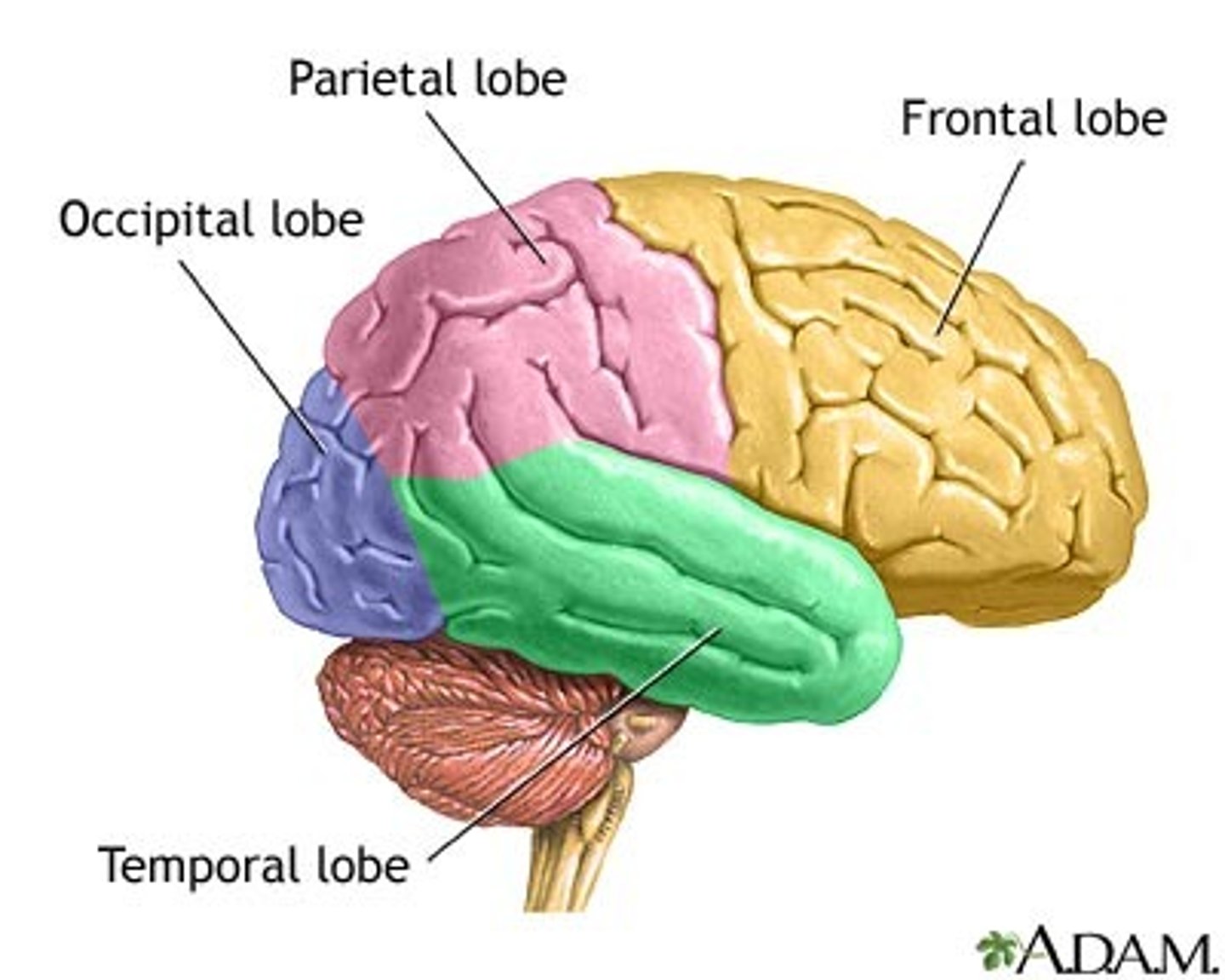
Neurotransmitter
A chemical released when a nerve impulse reaches a synapse
The neurotransmitter defuses across the synapse
Excitatory or inhibitory
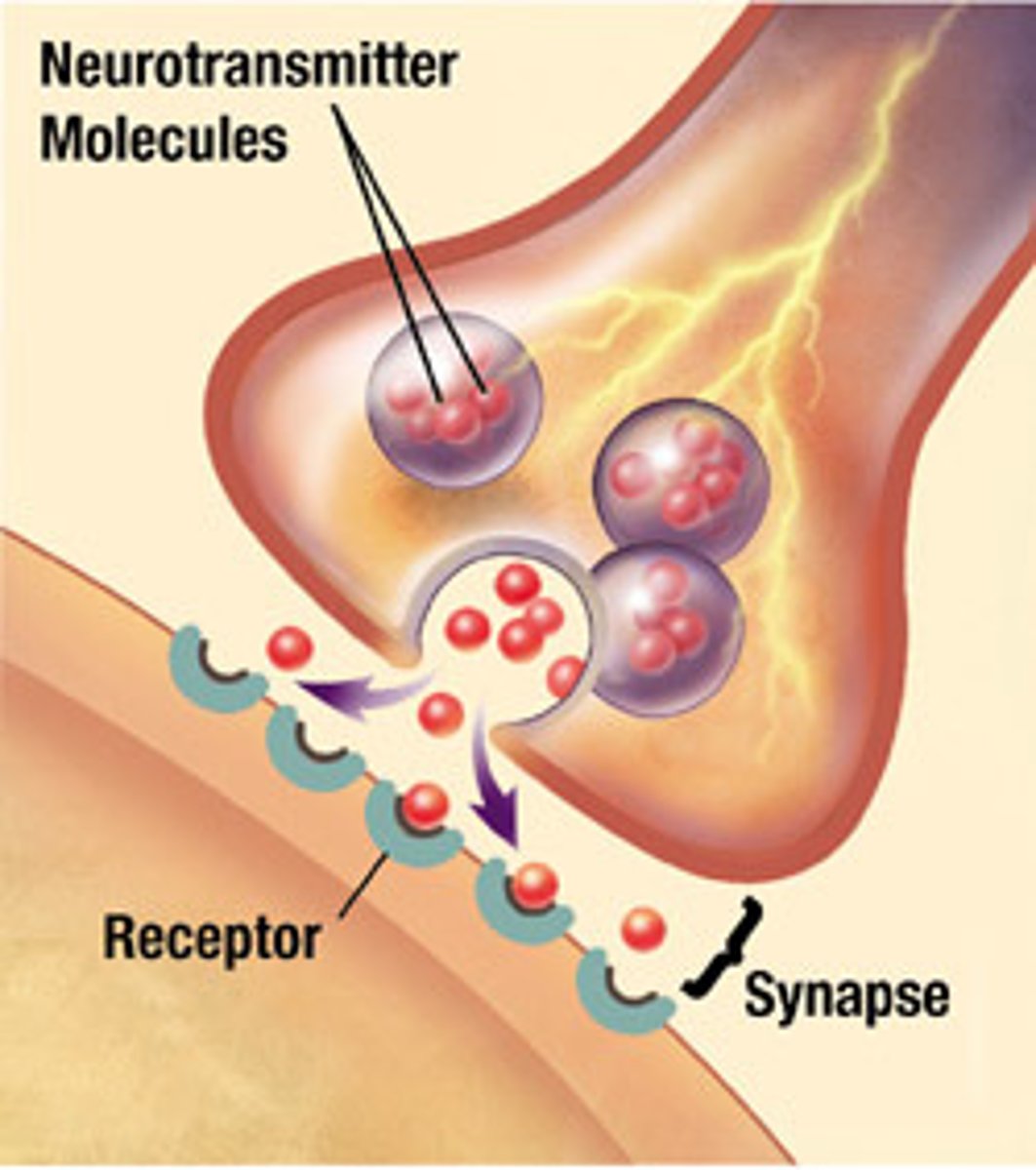
Excitatory neurotransmitter
Triggers nerve impulses in the receiving neuron and stimulates the brain into action
Example - Dopamine associated with motivation
Inhibitory Neurotransmitter
Inhibit nerve impulses in order to calm the brain and balance mood
Example - Serotonin stabilises mood
Hormones
Chemicals secreted into the bloodstream by endocrine glands in response to a signal from the brain.
Travel to their target cells and exert their influence by stimulating cell receptors
The presence of a hormone causes a physiological reaction in the cell altering the cell's activity

Biological approach - Evaluation
+Uses of scientific methods of investigation: uses a wide range of precise and highly scientific methods including fMRI an d EEGs scans, family/ adoption studies, drug trials. With this, it is possible to accurately measure biological and neural processes in ways that are not open to bias. This suggests that data is objective and unbiased, and therefore, reliable.
+Real life applications: increased understanding of biochemical processes in the brain has led to the development of psychoactive drugs to treat mental illnesses such as depression. Although these drugs are not effective for all patients, they have revolutionised treatments for many. This is a strength as it has led to the improvement of living conditions for patients so that they can live a relatively normal life.
-Difficult to separate nature (genes) from nurture (environment): this approach can’t explain why concordance rates are often higher for DZ twins than ordinary siblings, though they have 50% shared genes. Also, they are exposed to similar environmental conditions. This suggests that behaviour could just as easily be interpreted as nurture (environment) as could nature (genes)
-Determinist: it views behaviour as caused by internal factors that we have no control over, allowing people to blame undesirable behaviour on genetics. It can cause implications for society such as the legal system as one blames genetics for their actions rather than accepting moral responsibility
Assumptions of Psychodynamic approach
most behaviour is influenced by the unconscious mind
mental processes have conflicts and conflict reolusiton determines adjustment
our childhood experiences determine our adult relationships
Dreams are expressions through symbols (e.g climbing = intercourse)
The role of the unconscious
Most of the mind is made up of the unconscious (80%)
A vast storehouse of biological drives and instincts that influence behaviour and personality
What is the conscious mind?
visible i.e. it is known and controlled by us
What is the subconscious mind?
partially visible, partially beneath i.e. potentially known
What is the unconscious mind?
‘beneath the surface’ i.e. completely unknown
Structure of Personality (triparte)
3 Components:
id
ego
superego
The id
Present form birth and is the storehouse of wants, desire, etc
It’s hedonistic - operated on the pleasure principle
The ego
functional part of personality that operates on the morality principle. It mediates between the id and superego.
The superego
the internalised right and wrong sense of our mind’s conscientiousness and is based on the morality principle

Defence mechanisms
Repression
Denial
Displacement
Repression
forgetting on a distressing memory of the conscious mind. Eg. not recalling a traumatic childhood event such as abuse.
Denial
refusing to acknowledge some aspect of reality e.g. student with poor grades telling themselves that grades don't matter
Displacement
transferring feeling from a true source of distressing emotion onto a substitute target e.g Anna ‘O’ transferred the distress of her father’s death onto her doctor, convincing herself she was pregnant.
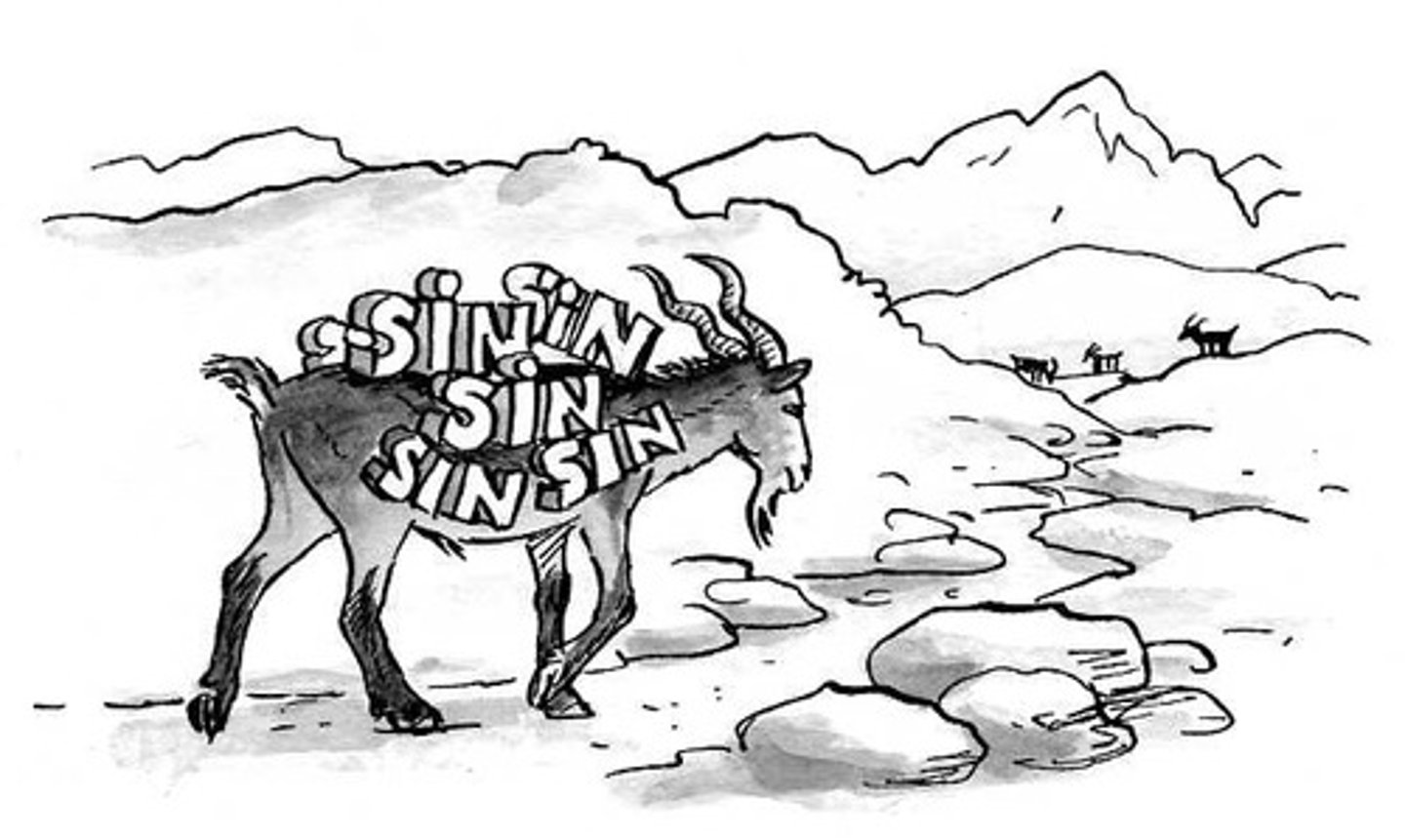
Psychosexual development theory
Child development occurs in 5 stages, each of which is marked by a different conflict that the child must resolve to pass to the next stage.
Any unresolved conflict leads to fixation and certain characteristics of that stage will be carried through to adult life
Psycho sexual stages of development
Oral
Anal
Phallic
Latent
Genital
Psycholsexual development - Oral Stage
Occurs from 0-1 Years
Focus of pleasure is the erogenous stage of the mouth e.g sucking
Consequence of unresolved conflict - Oral fixation (Smoking, biting nails, sarcasm, critical)

Psychosexual development - Anal Stage
Occurs from 1-3 years
Focus of pleasure is the anus. The child gains pleasure form retention and expulsion of faeces.
Consequence of unresolved conflict
- Anal retentive (perfectionist, obsessive)
- Anal expulsive (thoughtless, messy)
Psychosexual development - Phallic stage
Occurs from 3-6 years
Focus of pleasure is the genital area. Boys experience the oedipus complex, girls experience the electra complex. Resolution of these complexes form their gender identity and moral basis.
Consequence of unresolved conflict - boys develop castration anxiety and girls develop penis envy
Psychosexual development - Latent Stage
Earlier conflicts are repressed. Sexual drive is present but dormant.
same sex role identification develops
Psychosexual development - Genital Stage
Occurs from 12+ years
Sexual desires become conscious alongside the onset of puberty. Focus is directed to gaining heterosexual pleasure through intercourse.
Consequence of unresolved conflict - Difficulty forming heterosexual relationships. Sexual perversions may develop if fixated at earlier stage.
Oedipus Complex
During phallic stage, boys develop incestuous feelings towards their mother and murderous hatred for their father as he is their rival.
Fearing their father will castrate them, boys repress their feelings for their mother and identify with their father, taking on his gender role and moral values.
Electra complex
During phallic stage, girls experience penis envy.
They desire their father as the penis is the primary love object and hate their mother as she is their rival.
Girls will give up the desire for their father over time and replace this with a desire for a baby, identifying with their mother in the process.
Case study of Little Hans
Offers support for oedipus complex.
Hans' phobia was a result of displacement in which his repressed fear of his father was transferred onto horses.
Horses were a symbolic representation of Hans' real unconscious fear of castration.
Freud suggested the Hans resolved his conflict by fantasising about himself with a large penis and married to his mother, allowing him to overcome castration anxiety and identify with his father
Psychodynamic Approach - Evaluation
+Explanatory power - though bizarre and controversial, it has nevertheless had a huge influence on psychology. It remains the dominant force in psychology for the first half of the 20th century and has been used to explain a wide range of phenomena including personality development, abnormal behaviour, moral development and gender. It’s also significant in drawing attention tot he connection between experiences in childhood, such as our relationships with our parents and later development
+Practical application: it has led to the development of psychoanalysis. Employing a range of techniques designed to assess the unconscious, such as hypnosis and dream analysis, it is the forerunner to many modern-day psychotherapies that have since been established. However, though Freudian therapists claim success with many patients, psychoanalysis has been criticised as inappropriate or harmful for people suffering more serious mental disorders like schizophrenia
-The case study method: can't make universal claims based on a unique, individual case. Freud’s interpretations were also subjective. This approach lacks a scientific base and rigour.
-Psychic determinism: Freud believed that there was no such thing as an accident when it came to human behaviour. This approach explains that all behaviour - even accidents - is determined by unconscious conflicts that are rooted in childhood such that any free will we think we have is an illusion
Assumptions of the Humanistic approach
Focus on conscious experience rather than behaviour, Free will rather than Determinism, Discussion of experience than use of experimental method.
Stresses importance of personal growth and fulfilment
Humans are unique individuals and general laws should not be applied to everyone.
Origins of Humanism
Developed in the 1950s and called the ‘Third Force’ which aimed to replace the two main approaches, behaviourism and psychodynamic. It’s different to the other approaches as it claims that humans have free will.
Humanistic - Free will
The notion that humans can make choices and are not determined by external or internal forces
Sees that we are active agents who have the ability to determine our own development
Humanistic - Self actualisation
Every person has an innate tendency to strive to achieve their full potential.
Represents the top level of Maslow's hierarchy of needs.
All 4 lower levels of the hierarchy must be met before the individual can work towards self actualisation.
Maslow's Hierarchy of Needs - stages
Self Actualisation
^
Self-esteem
^
Love/belonging (social)
^
Safety + Security
^
Physiological
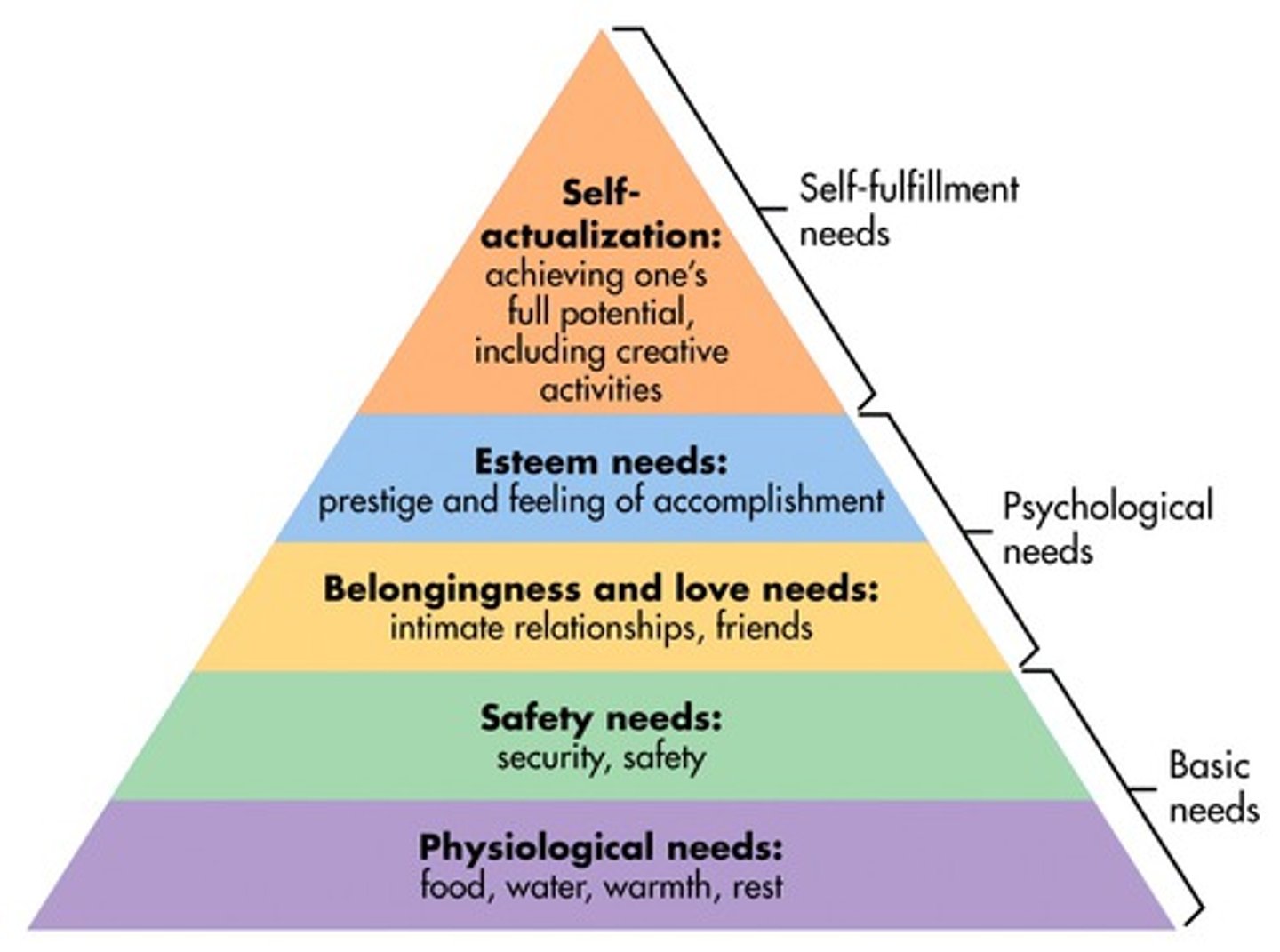
Maslow's Hierarchy of Needs
Developed in the 1950s by Maslow who proposed that we have to fulfil certain needs before others in order of importance. Once all of these needs have been fulfilled, we can self-actualise.
Anything below self-actualisation is called a deficiency need whilst self-actualisation is a growth need. we canmove up and down through these stages in life - there are consequences if needs are unfulfilles at a specific stage
Consequences of unfulfilled stage
Physiological needs - the inability for body to function properly
Safety - fear/ anxiety reactions
Belongingness and love - feelings of loneliness and/ or depression
Esteem - lack of confidence, feeling incompetent
Self-actualisation - n/a
The Self and Congruence
For personal growth to be achieved, an individual's perception of their 'self' must equal their 'ideal self' - congruence.
If too big a gap exists between the 2 'selves' the person will experience incongruence and self-actualisation will not be possible due to the negative feelings of self-worth that arise from incongruence.
Client-centred Therapy to treat incongruence
Developed by Rodgers
Rodgers claimed that issues experienced as adults such as worthlessness can be explained by a lack of unconditional positive regard.
As a therapist, Rodgers would provide clients with unconditional positive regard
Unconditional positive regard
Unconditional love.
A parent who sets boundaries or limits on their love for the child violates this and this results in the child storing up psychological problems for the future.

Client centred therapy
Centred on the person.
The individual is the expert on their own condition.
Non-directive therapy.
Client is encouraged tp develop positive self-regard to overcome this disparity within a therapeutic atmosphere that is supportive and non-judgemental.
Role of Therapist in Client-centred Therapy
Provides client with genuineness, empathy and unconditional positive regard.
Gestalt therapy
Patient is encouraged to accept the whole of themselves. Techniques include confronation, roleplay and dream analysis.
Humanistic approach - evaluation
+Not Reductionist: This approach looks holistically at behaviour compared to other approaches. Behaviourists redue behaviour to stimulus-response loops, Freud reduced behaviour to the conflict between id, ego and superego, biological psychologists reduce behaviour to its basic physiological processes and cognitive psychologists reduces behaviour to computer-like systems. Thi means this approach may have higher validity than other approaches because it considers meaningful human behaviour within a real-life context.
-Limited Application: Though it’s true that client-centered therapy has revolutionised counselling techniques and Maslow’s hierarchy of needs has been used to explain motivation, it remains the case that the approach has had a limited impact within the discipline of psychology as a whole. This may be due to humanistic psychology a sound evidence base and has been described as, not a comprehensive theory, but a rather loose set of concepts.
+Positive Approach: has been praised for ‘bringing back the whole person into psychology’ and promoting a positive image of the human condition. Compared to the psychodynamic approach, Freud saw humans as slaves of their past and claimed all of us existed somewhere between ‘common unhappiness and absolute despair’. Humanistic psychology offers a refreshing and optimistic alternative. It sees all people as basically good, free to work towards the achievement of their potential and in control of their lives.
-Unstable concepts: humanistic psychology does include a number a vague ideas that are abstract and difficult to test. Concepts like self-actualisation and congruence may be useful therapeutic tools but would prove problematic to assess under experimental conditions. Rogers did attmept to introduce more rigour into his work by developing the Q-sort - an objective measure of progress in therapy. Nevertheless as would be expected of an approach that describes itself as anti-scientific, it’s short in empirical enidence to support its claims.
Essay Plan - Describe + Evaluate Behaviourist Approach
AO1
Classical Conditioning
Operant Conditioning
Blank Slate
No difference between man and brute
AO3
Token Economy
Mechanistic view of behaviour
Extrapolation issues
Nomothetic
Essay Plan - Describe + Evaluate SLT
AO1
Learn through observation
Vicarious reinforcement
Mediational processes
Identification
AO3
Bandura Study
Underestimates biological influence
Ensure role models for children are suitable
Phillips 1986 study (boxing - homicide rates)
Essay Plan - Describe + Evaluate Cognitive Approach
AO1
Study of internal mental processes
Theoretical models
Role of schema
Cognitive neuroscience
AO3
Machine reductionism
CBT treatment for depression
Scientific objective methods
Issue with inference
Essay Plan - Describe + Evaluate Biological Approach
AO1
Behaviour is biological
Neurons + nervous system
Neurotransmitters
Hormones
AO3
Drug treatment for OCD
Manipulate neurotransmitters to reduce SZ chance
Scientific methods of investigation
Evolutionary explanation irrelevant in modern world
Essay Plan - Describe + Evaluate Psychodynamic Approach
AO1
Role of unconscious
Structure of personality
Psychosexual stages of development
Oedipus/Electra complexes
AO3
Little Hans case study
Case study method is highly subjective
Issues with falsification
Negative approach
Essay Plan - Describe + Evaluate Humanistic Approach
AO1
Self actualisation
Humans are unique
Self and Congruence
Hierarchy of needs
AO3
Client centred therapy
Idiographic
Holistic
Positive approach
Biological Approach Linked to Topics
Schizophrenia - Drug treatment.
Psychopathology - Drug treatment of OCD.
Cognitive Approach linked to Topics
Schizophrenia - Cognitive explanation for SZ.
Psychopathology - Cognitive explanation for depression.
Learning Approach linked to Topics
Attachment - Learning theory.
Psychopathology - Behavioural explanation and treatment of phobias.
Psychodynamic Approach linked to Topics
Attachment - Maternal deprivation.
Gender - Oedipus and Electra.
Humanistic Approach linked to Topics
Social Influence - Internal LoC.
Psychopathology - Client centred therapy.
Structuralism
to isolate the structures of consciousness
Psychology
the study of the human mind and its functions, especially those affecting behaviour in a given context